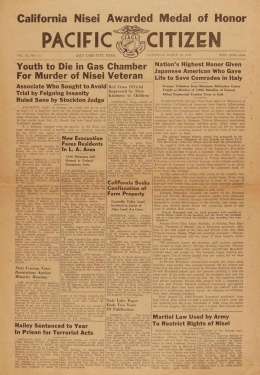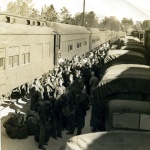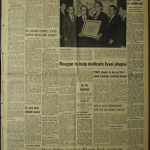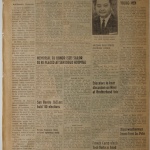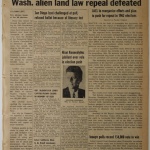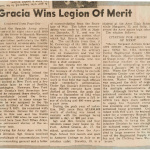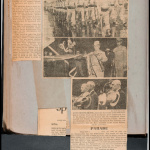Congressional Medal of Honor recipients
The Medal of Honor, the country's highest military honor, has been awarded to twenty-one Japanese American soldiers—all members of either the 100th Infantry Battalion or the 442nd Regimental Combat Team —for actions during World War II. Only one of these was awarded contemporaneously. A 1990s review of African American and Asian American candidates who might have been overlooked at the time led to the other awards being presented in 2000.
The Medal of Honor
The Medal of Honor—colloquially known as the Congressional Medal of Honor because it is presented by the President in the name of Congress—was established in 1861. Some 2,500 medals were awarded for action during the Civil War, though some 900 of these were later revoked. In 1918, a broad revision of the award system was completed, with standards for the Medal of Honor greatly raised and new awards such as the Distinguished Service Cross and the Silver Star instituted. This revision led to many fewer receiving it; for action during World War II, only 422 were awarded. Further revisions to the criteria in 1963 dictated that the award only be given for heroic actions in combat. Since the end of the Vietnam War, only a handful of medals have been awarded. [1]
World War II
As has been well documented, Japanese American soldiers served heroically during World War II and received many decorations and honors both individually and as groups. However, some felt that the number of honors they received were not commensurate with their achievements. Many Japanese American members of the 442nd or 100th were recommended for the Medal of Honor, but all saw their honors downgraded to Distinguished Service Crosses or even to Silver Stars. Towards the end of the war, Japanese American Citizens League publicist Mike Masaoka approached his old mentor, Senator Elbert Thomas of Utah, then the chairman of the Senate Foreign Relations Subcommittee, to inquire about the seeming disparity. In his autobiography, Masaoka suggests that Thomas's subsequent inquiry led to the Medal of Honor being awarded to the only case still pending, that of Sadao Munemori . [2]
That single award would be the only Medal of Honor awarded to a Japanese American—or indeed any Asian American—for action during World War II. Forty-seven Japanese Americans received Distinguished Service Crosses, the next highest award. The ratio of Medals of Honor to Distinguished Service Crosses for all troops in World War II was about one to nine, with the ratio being closer to one to three in some highly decorated units. The one to forty-seven ratio for the 100th and 442nd seemed artificially low to many. [3]
1990s Review
In subsequent years, three Japanese Americans received the Medal of Honor for action in later wars: Hiroshi "Hershey" Miyamura for action during the Korean War and Terry T. Kawamura and Rodney J. T. Yano for action during the Vietnam War. Since Munemori, Kawamura, and Yano were all killed in action, Miyamura was for many years the only living Japanese American Medal of Honor recipient.
While only one Medal of Honor was awarded to an Asian American for action during World War II, none were awarded to African American soldiers. In 1993, Congress ordered a review of potential African American honorees to see if any had been overlooked. A review team led by Daniel K. Gibran of Shaw University eventually recommended ten candidates for the Medal of Honor. The Senior Army Decorations Board voted to update seven of these candidates and President Bill Clinton presented the medals on January 13, 1997.
This review led members of the Japanese American community to seek a similar review. In 1995, Senator Daniel Akaka introduced legislation to require the army and navy to review Asian Americans and Pacific Islanders who had been awarded the Distinguished Service Cross or Navy Cross for possible upgrade. The legislation was passed and signed into law in 1996. James C. McNaughton, a historian at the Defense Language Institute Foreign Language Center of the Presidio in Monterey, California, led the research team. Eventually, twenty-one were recommended for upgrade, with a twenty-second subsequently approved based on separate legislation. All but two of these awards went to members of the 100th or 442nd. President Bill Clinton presented the awards on June 21, 2000. "Rarely has a nation been so well served by a people it has so ill-treated," he stated. "They risked their lives, above and beyond the call of duty. And in so doing, they did more than defend America; in the fact of painful prejudice, they helped to define America at its best." [4]
Recipients
Contemporaneous
Pfc. Sadao S. Munemori
Company A, 100th Infantry Battalion, 442nd Regimental Combat Team
Killed in action near Seravezza, Italy, April 5, 1945
Born: Los Angeles, California, August 17, 1922
Entered service: Los Angeles, California
Died: April 5, 1945
Awarded in 2000
Pvt. Barney F. Hajiro
Company I, 442nd Regimental Combat Team
For actions in the Vosges Mountains of France, October 1944
Born: Pu'unene, Maui, Hawai'i, September 16, 1916
Entered service: Honolulu, Hawai'i
Died: January 21, 2011
Pvt. Mikio Hasemoto
Company B, 100th Infantry Battalion (Separate)
Killed in action in Cerasuolo, Italy, November 29, 1943
Born: Honolulu, Hawai'i, July 13, 1916
Entered service: Schofield Barracks, Hawai'i
Died: November 29, 1943
Pvt. Joe Hayashi
Company K, 442nd Regimental Combat Team
Killed in action near Tendola, Italy, April 20 and 22 1945
Born: Salinas, California, August 14, 1920
Entered service: Pasadena, California
Died: April 22, 1945
Pvt. Shizuya Hayashi
Company A, 100th Infantry Battalion (Separate)
For actions at Cerasulolo, Italy, November 29, 1943
Born: Waialua, Oahu, Hawai'i, November 28, 1917
Entered service: Schofield Barracks, Hawai'i
Died: March 12, 2008
2nd Lt.
Daniel K. Inouye
Company E, 442nd Regimental Combat Team
For actions near Mt. Nebbione, Italy, April 1945
Born: Honolulu, Hawai'i, September 7, 1924
Entered Service: Honolulu, Hawai'i
Tech. Sgt. Yeiki Kobashigawa
Company B, 100th Battalion (Separate)
For actions near Lanuvio, Italy, June 2, 1944
Born: Hilo, Hawai'i, September 28, 1917
Entered service: Honolulu, Hawai'i
Died: March 31, 2005
Staff Sgt. Robert T. Kuroda
Company H, 442nd Regimental Combat Team
Killed in action at Bruyeres, France on October 20, 1944
Born: Aiea, O'ahu, Hawai'i, November 8, 1922
Entered service: Honolulu, Hawai'i
Died October 20, 1944
Pfc. Kaoru Moto
Company C 100th Battalion (Separate)
For actions near Castellina, Italy, July 7, 1944
Born: Hawai'i, April 25, 1917
Entered service: Spreckelsville, Maui, Hawai'i
Died: August 26, 1992
Pfc. Kiyoshi Muranaga
Company F, 442nd Regimental Combat Team
Killed in action at Suvereto, Italy, June 26, 1944
Born: Los Angeles, California, February 16, 1922
Entered service: Amache, Colorado
Died: June 26, 1944
Pfc. Masato "Curly" Nakae
Company A, 100th Infantry Battalion, 442nd Regimental Combat Team
For actions at Pisa, Italy, August 19, 1944
Born: Lihue, Kaua'i, Hawai'i, December 20, 1917
Entered service: Honolulu, Hawai'i
Died September 4, 1998
Pvt. Shinyei Nakamine
Company B, 100th Infantry Battalion (Separate)
Killed in action at La Torreto, Italy, June 2, 1944
Born: Wai'anae, O'ahu, Hawai'i, January 21, 1920
Entered service: Honolulu, Hawai'i
Died: June 2, 1944
Pfc. William Nakamura
Company G, 442nd Regimental Combat Team
Killed in action at Castellina, Italy, July 1944
Born: Seattle, Washington, January 21, 1922
Entered service: Minidoka, Idaho
Died: July 4, 1944
Pfc. Joe M. Nishimoto
Company G, 442nd Regimental Combat Team
Killed in November 1944, eight days after his heroic act at La Houssiere, France for which his is honored
Born: Fresno, California, February 21, 1919
Entered service: Marion, Ohio
Died: November 15, 1944
Staff Sgt. Allan M. Ohata
Company B, 100th Infantry Battalion (Separate)
For actions at Cerasuolo, Italy, November 29–30, 1943
Born: Honolulu, Hawai'i, September 13, 1918
Entered service: Honolulu, Hawai'i
Died: October 17, 1977
Technician 5th Grade James K. Okubo
442nd Regimental Combat Team
For actions near Biffontaine, France, October–November, 1944
Born: Anacortes, Washington, May 30, 1920
Entered service: Bellingham, Washington
Died: January 29, 1967
Tech. Sgt. Yukio Okutsu
Company F, 442nd Regimental Combat Team
For actions at Mt. Belvedere, Italy, April 7 1945
Born: Koloa, Kaua'i, Hawai'i, November 3, 1921
Entered service: Koloa, Kaua'i, Hawai'i
Died: August 24, 2003
Pfc. Frank H. Ono
Company G, 442nd Regimental Combat Team
Born: June 5, 1923
For actions near Castellina, Italy, July 4, 1944
Entered service: North Judson, Indiana
Died: May 6, 1980
Staff Sgt. Kazuo Otani
Company G, 442nd Regimental Combat Team
Killed in action near Pieve Di S. Luce, Italy, July 15, 1944
Born: Visalia, California, June 2, 1918
Entered service: Gila River, Arizona
Died: July 15, 1944
Pvt. George T. Sakato
Company E, 442nd Regimental Combat Team
For actions at Biffontaine, France in October 29, 1944
Born: Colton, California, February 19, 1921
Entered service: Glendale, Arizona
Tech. Sgt. Ted T. Tanouye
Company K, 442nd Regimental Combat Team
For actions at Molina A. Ventoabbto, Italy, July 7, 1944
Born: Torrance, California, November 14, 1919
Entered service: Fort MacArthur, California
Died: September 6, 1944
Other Asian Americans awarded in 2000
Staff Sgt. Rudolph B. Davila of Vista, California, 7th Infantry, Third Army, for actions at Anzio, Italy in May 1944
Capt. Francis Brown Wai of Honolulu, Hawai'i, 34th Infantry Regiment, 24th Infantry Division, killed in action in Oct. 1944 at Leyte in the Philippines
For More Information
Asahina, Robert. Just Americans: How Japanese Americans Won a War at Home and Abroad . New York: Gotham, 2006.
McNaughton, James C., Kristen E. Edwards, and Jay M. Price. "'Incontestable Proof Will Be Exacted': Historians, Asian Americans, and the Medal of Honor." The Public Historian 24.4 (autumn 2002): 11–33.
The Medal of Honor . Video produced by the Go For Broke National Education Center, 2006.
Sterner, C. Douglas. Go For Broke: The Nisei Warriors of World War II Who Conquered Germany, Japan and American Bigotry . Clearfield, Utah: American Legacy Historical Press, 2008.
Footnotes
- ↑ James C. McNaughton, Kristen E. Edwards, and Jay M. Price, "'Incontestable Proof Will Be Exacted': Historians, Asian Americans, and the Medal of Honor," The Public Historian 24.4 (autumn 2002), 14.
- ↑ Mike Masaoka with Bill Hosokawa, They Call Me Moses Masaoka: An American Saga (New York: Morrow, 1987), 176–77.
- ↑ Robert Asahina, Just Americans: How Japanese Americans Won a War at Home and Abroad (New York: Gotham, 2006), 259–60. Later, in 2011, Shinyei "Rocky" Matayoshi was awarded the DSC. Independent researcher Isami Yoshihara has compiled a list of 49 Japanese Americans recipients of the DSC, one more than Asahina even including Matayshi. Megan Neunan, "Japanese-American awarded DSC for actions in WWII," U.S. Army website, June 13, 2011, https://www.army.mil/article/59449/japanese_american_awarded_dsc_for_actions_in_wwii , accessed on Jan. 27, 2023.
- ↑ Cited in Asahina, Just Americans , 8. The twenty-second, James K. Okubo, was upgraded from a Silver Star. "James K. Okubo," The Hall of Valor Project, Military Times, https://valor.militarytimes.com/hero/1590 , accessed on Jan. 27, 2023.
Last updated Jan. 27, 2023, 5:36 p.m..

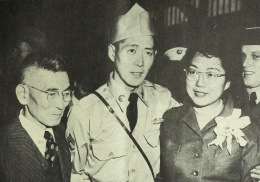 Media
Media
